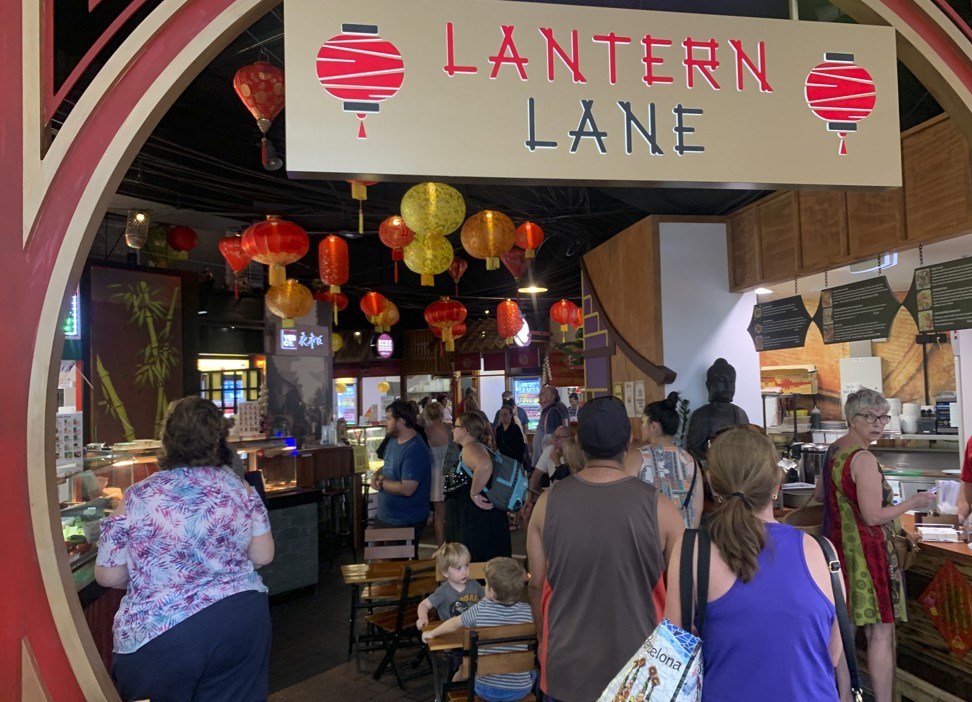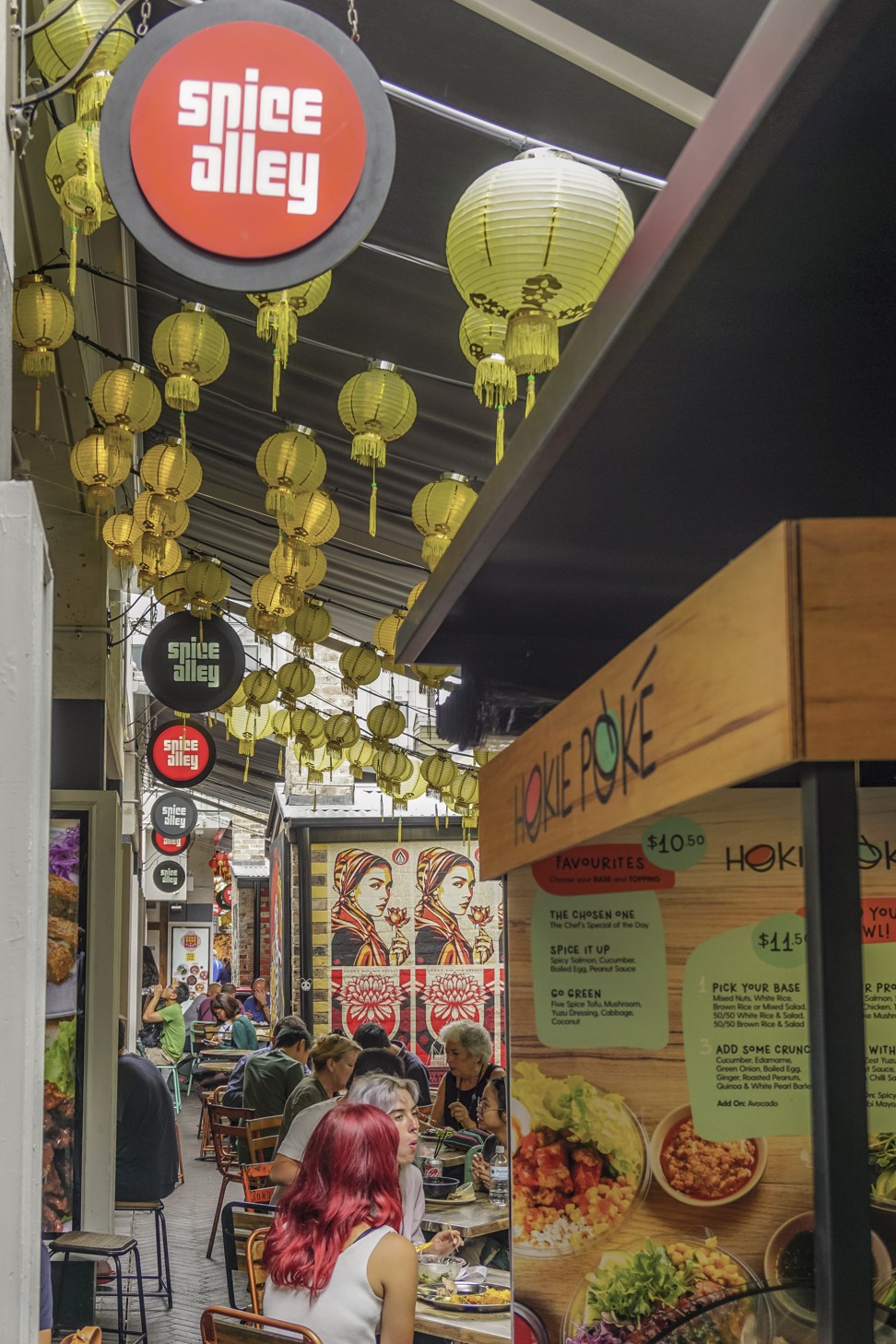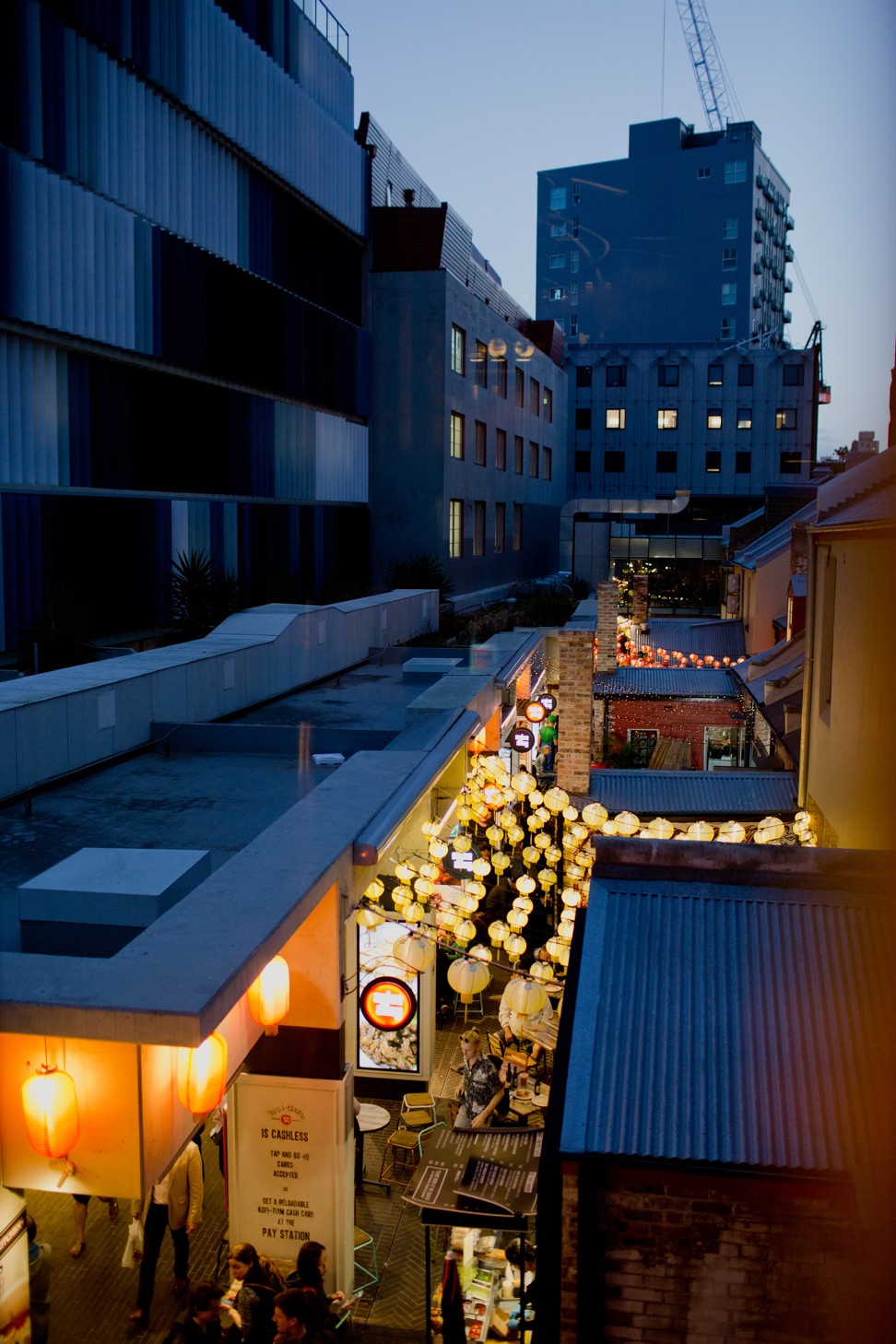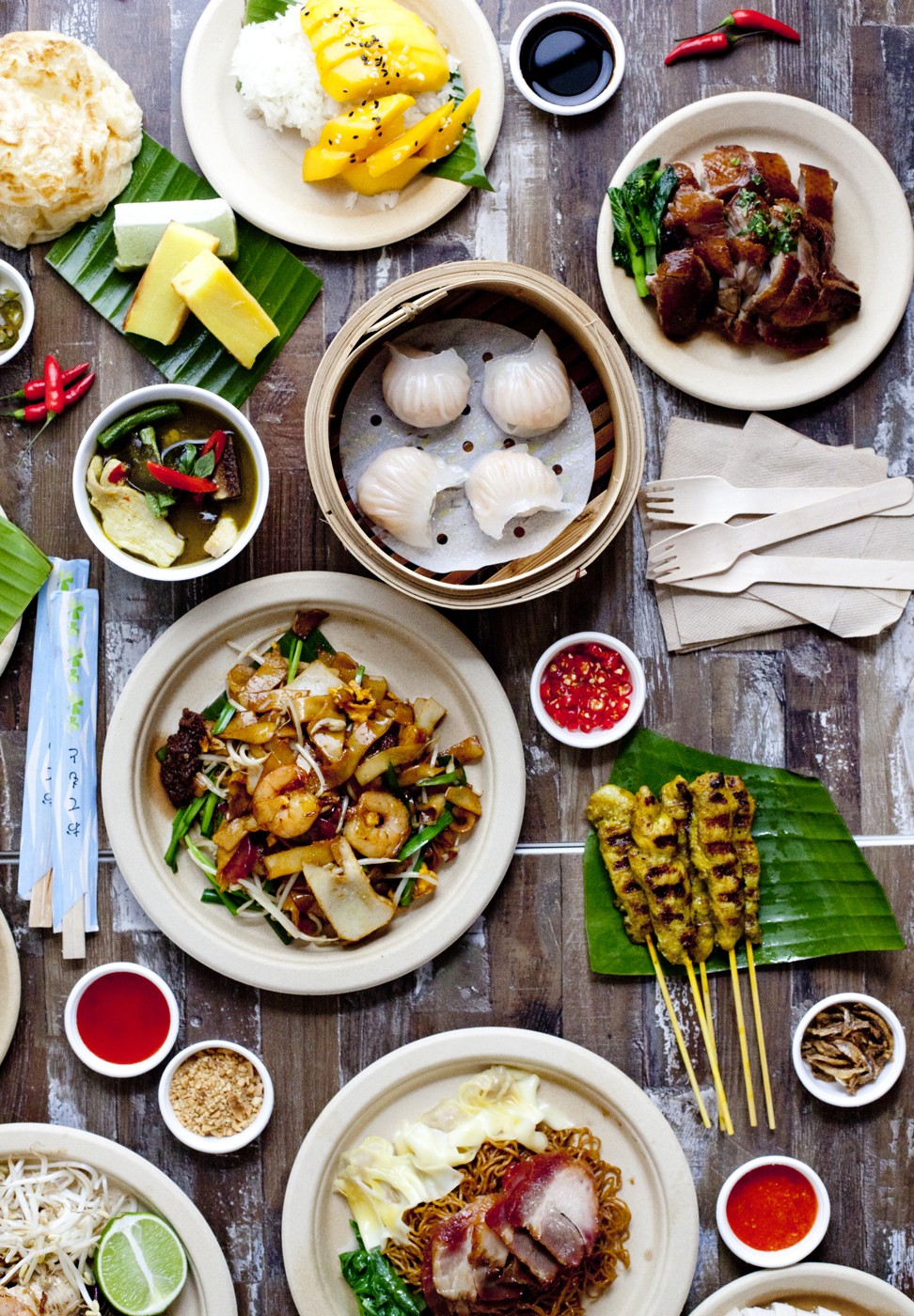
How Australia’s Asian food courts from Sydney to Cairns are winning over diners with their inexpensive dishes and Oriental styling
- Many Australian food courts are being converted into pan-Asian food alleys that wouldn’t look out of place in Seoul, Singapore or Bangkok
- Customers can choose dishes from an array of options, including Vietnamese, Thai, Japanese, Korean and Chinese

The woks spit as a rich scent of ramen broth, barbecued pork and sizzling beef fills the air, while customers compete for a seat in a crowded melange of tiny food shops.
Lit with red paper lanterns, this alley could be anywhere in Asia, from Seoul to Singapore, Bangkok or Beijing, but it’s in a shopping centre in the Australian city of Cairns.
A new trend in Australian food courts has emerged in recent years: areas built to resemble Asian alleyways. Inexpensive and atmospheric, they have proven hugely popular with Australian diners, who seem content to jostle for a table after paying a small price for a plate of food.
The growing Asianisation of food offerings in shopping centres across the country is replacing the earlier phenomenon of Americanisation, which was led by McDonald’s, KFC and Pizza Hut.

Asian food now dominates in many Australian food courts, dining precincts and food halls. Hanging hill roofs, red brick walls and pagoda-style arches set the scene in a good number of them.
Dubbed “destination dining” by developers, the pan-Asian-style dining spaces began spreading across the east coast capitals Brisbane, Sydney and Melbourne a decade ago, and recently reached Cairns in far north Queensland.

Five kilometres (3.1 miles) from Cairns’ central business district, in the Stockland shopping centre in Earlville, Lantern Lane is the latest of these culinary curiosities.
Opened in late September, the 80-seat dining hub was designed to “create an experience” for shoppers, says Stockland leasing executive Luke Stenner.
“It isn’t one culture that works the best,” Stenner says, explaining that the most successful strips have many food options from a variety of Asian nations. “A casual dining experience is really what people are after.”
Lantern Lane’s founder and CEO is Vietnam-born Jay Le, a former executive chef of the Hilton Hanoi Opera hotel. Le transformed a small section of the Stockland mall into a Chinatown-inspired laneway, where customers can choose dishes from an array of Vietnamese, Thai, Japanese, Korean and Chinese options.
Before Lantern Lane opened, Stenner says, locals could only taste the Vietnamese delights of Thanh Thanh – one of the operators in the lane – if they were lucky enough to be invited into Thanh’s home.
It was Le’s community ties that brought together home cooks including Thanh, and provided them with a space to share and sell their food – and Cairns diners are enjoying the results.

Farther down Australia’s eastern coast, to the southeast of Brisbane’s central business district in Upper Mount Gravatt, another innovative Asian dining strip, 8 Street, can be found in a Westfield shopping centre.
8 Street was launched by property developer David Wu in October 2014. This year Wu, who is a managing partner of the Asian grocer Sunlit, celebrated 8 Street’s fifth anniversary with combo deals pairing Asahi beer with Chinese jian bing pancakes, ma lang tang noodles and Japanese katsudon rice, and pork cutlet in its three of the 8 Street food outlets in Queensland.
The Brisbane space is a dining precinct bringing together 17 food retailers that serve dishes from China, Japan, Korea, Thailand and Vietnam, alongside a bar serving Asian beer.
Most Caucasians are far more educated [about Asian food] these days, so therefore they also know what a good version of a particular dish is
Katherena Koh, a Singaporean-Thai social media and marketing assistant based in Brisbane, says 8 Street can bring indecisive friends together.
“If I go with friends and we can’t think of one cuisine we all like, we go to 8 Street and get our own, and we can all still sit together,” she says. For Koh, who often visits during her 30-minute lunch break, the convenience of 8 Street’s takeaway options is also a huge plus, as is the cost.
In 2017, three years after 8 Street was established, Wu opened a second location in the Brisbane suburb of Mount Ommaney. He opened a third 8 Street in the Gold Coast suburb of Harbour Town in 2018, and in February this year, yet another opened, near Melbourne’s central business district.

Sydney, in New South Wales, welcomed two similar Asian dining concepts in 2016. Hawker Lane opened in a Westfield shopping centre in Chatswood, a suburb northeast of the city’s central business district, where a survey has shown that 34 per cent of the population identify as Chinese, and 28 per cent were born in either mainland China, Hong Kong or Taiwan.
According to newspaper reports, the Hawker Lane dining precinct is part of an A$125 million (US$86 million) renovation designed to cater to the local population.
The other concept is Spice Alley, located southeast of Sydney’s central business district. It is an open-air dining strip connected to a newly developed shopping and dining precinct.

Launched by Singaporean real estate tycoon Stanley Quek and his property development company Green Cliff, Spice Alley is located next to Masterchef Indonesia judge Arnold Poernomo’s famous Koi Dessert Bar in the Kensington Street Precinct, in a A$2 billion development called Central Park.
Kensington Street Precinct CEO Marcus Chang, an Australian born to a Chinese father and an English mother, says the idea behind Spice Alley “was to create something we’re used to”.
Unlike any of the other Asian food courts and precincts, Spice Alley’s operation is completely cashless. Customers pay by card or use special gift vouchers. This is intended to “improve speed of service” but it also complies with guidelines of the Safe Food Australia body, which restricts cash register operators from handling money if they are directly involved with food production.

Spice Alley brought in operators of dining places where Chang had eaten for 15 years, he says, pointing to chefs Alex Lee from Ginger and Spice, and Jim Yong from Uncle Jim’s and the Chef’s Gallery group.
Several reasons are cited for the success of these Asian food strips in Australia. Among them is the centralised management system that helps bring together talented chefs who may lack the skills to navigate the permits and licences required to run their own businesses. Wu says that in Mount Gravatt, 8 Street’s flagship precinct, his top two restaurateurs don’t even speak English.
“8 Street’s project management team holds our tenants’ hands over all these process[es] and delivers ready-to-open tenancies for them,” he says.

The tenants have also benefited from marketing and advertising initiatives that have helped draw in customers.
“Most Asian food operators won’t spend money on marketing once the business has opened,” Wu says. “8 Street management takes care of all ongoing operational issues, so the tenants only need to focus on food quality and collection of money.”
Before opening Lantern Lane in Cairns, Stockland shopping centre recovered three underperforming sites: a fish and chip shop, a carvery, and an Asian takeaway.

“The key to North Queensland being the right place for us is its multiculturalism,” says Stockland’s Stenner.
“Most Caucasians are far more educated these days, so therefore they also know what a good version of a particular dish is,” he adds. “The new customer is far more educated and their taste buds have evolved. You can’t serve the same old thing you’ve served them for years that sits in a bain-marie.”